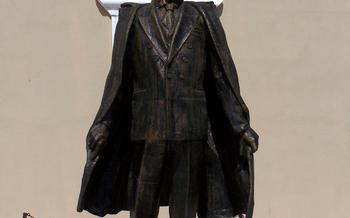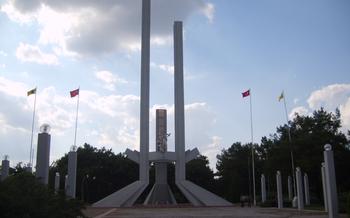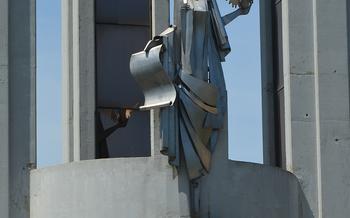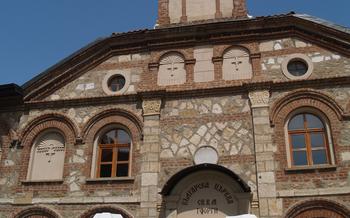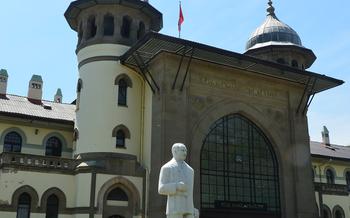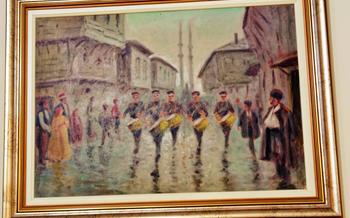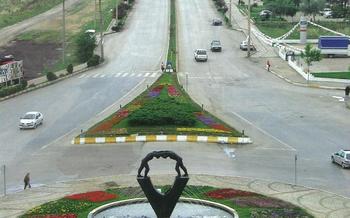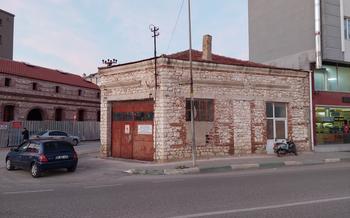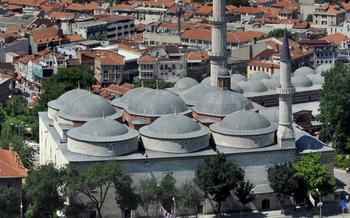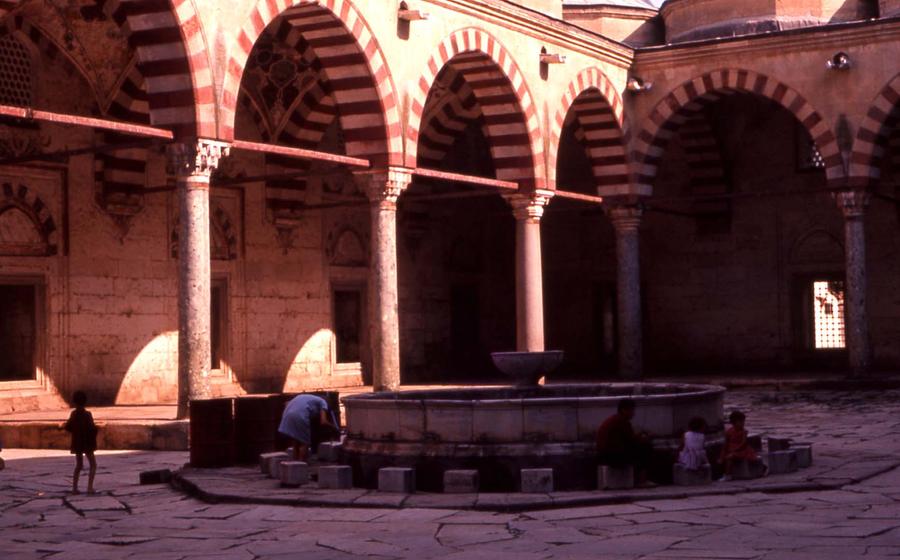
Balkan Şehitliği (Balkan Martyrs' Cemetery)
- Atop the Hill: A Cemetery with a Scenic Perspective
- A Reflection of the Past: The History Behind the Cemetery
- A Place of Honor: The Layout and Design of the Cemetery
- Honoring the Fallen: Notable Graves and Personalities
- A Symbol of Unity: The Diverse Backgrounds of the Soldiers
- A Place of Remembrance and Reflection
- Preservation and Maintenance: Ensuring the Legacy
- A Walk Through History: Guided Tours
- Respectful Etiquette: Visiting Guidelines
- A Place of Peace and Serenity
- Beyond the Cemetery: Exploring Edirne
- Capturing the Essence: Photography and Videography
- A Journey Through Time: Historical Context
- Insider Tip: A Hidden Gem
Atop the Hill: A Cemetery with a Scenic Perspective
Perched atop a hill overlooking the city of Edirne, the Balkan Martyrs' Cemetery stands as a solemn testament to the tragic loss of life during the Balkan Wars. Its prominent position not only commands a breathtaking panoramic view of the surrounding landscape but also serves as a constant reminder of the sacrifice made by countless soldiers. The cemetery, with its rows of neatly arranged graves and poignant memorials, is not just a burial ground but a place of profound remembrance and mourning, inviting visitors to pause and reflect on the horrors of war and the preciousness of peace.
A Reflection of the Past: The History Behind the Cemetery
The Balkan Wars, fought between 1912 and 1913, were a series of conflicts that resulted in the dissolution of the Ottoman Empire and the emergence of new nation-states in the Balkans. The wars were marked by immense bloodshed and loss of life, with thousands of soldiers perishing on both sides.
In the aftermath of the wars, the Balkan Martyrs' Cemetery was established in Edirne to honor the memory of the fallen soldiers. The cemetery serves as a poignant reminder of the sacrifices made by these brave individuals who fought for their respective nations.
The site chosen for the cemetery holds great significance. Situated atop a hill overlooking the city of Edirne, the cemetery offers a panoramic view of the surrounding landscape, creating a serene and contemplative atmosphere. It is a place where visitors can come to pay their respects, reflect on the past, and remember the tragic events that unfolded during the Balkan Wars.
The establishment of the Balkan Martyrs' Cemetery was not only an act of remembrance but also a symbol of reconciliation and peace. The cemetery stands as a testament to the shared sacrifices made by soldiers from different backgrounds, united in their devotion to their countries. It is a place where people can come together to honor their fallen heroes and work towards a future free from conflict and bloodshed.
The ongoing efforts to preserve and maintain the Balkan Martyrs' Cemetery ensure that the memory of the fallen soldiers lives on. The cemetery serves as a valuable reminder of the horrors of war and the importance of peace and understanding. By visiting the cemetery and paying our respects, we can help to ensure that the sacrifices made by these brave individuals are never forgotten.
A Place of Honor: The Layout and Design of the Cemetery
The Balkan Martyrs' Cemetery stands as a testament to the fallen soldiers, not only through its symbolic significance but also through its architectural design and layout. The cemetery's design reflects a deep respect for the departed, with each element contributing to a serene and reverent atmosphere.
The cemetery is organized into rows of graves, each marked with a tombstone. The tombstones are made of white marble and feature inscriptions in both Turkish and Arabic. The inscriptions include the soldier's name, rank, unit, and date of death. Many of the tombstones are also adorned with symbols and motifs, such as the Turkish flag, the crescent moon and star, and the laurel wreath.
The overall atmosphere of the cemetery is one of reverence and respect. The white marble tombstones, the neatly arranged rows of graves, and the serene surroundings create a space that encourages visitors to pause, reflect, and pay their respects to the fallen soldiers.
Honoring the Fallen: Notable Graves and Personalities
Amidst the rows of graves in the Balkan Martyrs' Cemetery, certain individuals stand out for their remarkable stories and contributions. One such figure is Mustafa Kemal Atatürk, the founder of modern Turkey. Atatürk, who fought in the Balkan Wars as a young officer, holds a special place in the hearts of the Turkish people. His grave, marked by a simple yet dignified tombstone, is a frequent pilgrimage site for those who wish to pay their respects to this legendary leader.
Another notable figure is Fevzi Çakmak, a distinguished military commander who played a crucial role in the Balkan Wars. Çakmak's strategic brilliance and leadership skills earned him the respect and admiration of his troops. His grave, adorned with a majestic obelisk, stands as a testament to his unwavering dedication to his country.
Among the fallen soldiers buried in the cemetery, the stories of ordinary individuals who displayed extraordinary courage and sacrifice are equally poignant. One such story is that of Mehmetçik, a young soldier who lost his life while defending his homeland. Mehmetçik's grave, marked by a simple headstone bearing his name and the date of his death, serves as a reminder of the countless unsung heroes who gave their lives for their country.
Visiting the graves of these notable individuals and learning about their stories evokes a range of emotions, from pride and gratitude to sadness and reflection. Their resting place within the Balkan Martyrs' Cemetery serves as a powerful reminder of the sacrifices made by so many during the Balkan Wars, and the enduring legacy of those who fought and died for their country.
A Symbol of Unity: The Diverse Backgrounds of the Soldiers
The Balkan Martyrs' Cemetery stands as a testament to the diverse backgrounds of the soldiers who fought and sacrificed their lives during the Balkan Wars. Within its hallowed grounds, soldiers of different ethnicities, religions, and nationalities lie side by side, united in their shared struggle for freedom and independence.
The cemetery bears witness to the rich tapestry of cultures and traditions that characterized the Balkan region during this tumultuous period. Among the fallen soldiers, one can find Muslims, Christians, and Jews, all of whom fought valiantly for their respective homelands. The graves of Albanians, Bulgarians, Greeks, Serbs, and Turks stand side by side, symbolizing the unity and camaraderie that existed among the soldiers despite their cultural differences.
This diversity of backgrounds highlights the fact that the Balkan Wars were not merely conflicts between nations, but also struggles for individual freedoms and the right to self-determination. The soldiers buried in the cemetery represent the countless individuals who fought for a better future for their communities, regardless of their ethnic or religious affiliations.
The Balkan Martyrs' Cemetery serves as a powerful reminder of the shared sacrifices made by people from all walks of life during the Balkan Wars. It stands as a symbol of unity, reconciliation, and peace, reminding us that even in the darkest of times, the human spirit can triumph over adversity and division.
A Place of Remembrance and Reflection
The Balkan Martyrs' Cemetery is not just a historical site; it is also a place of remembrance and reflection. Visitors from all over the world come to pay their respects to the fallen soldiers and honor their sacrifice. The atmosphere in the cemetery is one of reverence and contemplation, as people take a moment to reflect on the futility of war and the importance of peace.
The graves of the soldiers are a poignant reminder of the human cost of war. Each tombstone bears the name, rank, and date of death of the soldier, as well as a brief inscription that often tells a story of bravery and sacrifice. Visitors can learn about the individual stories of the soldiers by reading these inscriptions and imagining the lives they led.
The cemetery is also a place where people can come to mourn the loss of loved ones. For many families, the cemetery is the only place where they can visit the graves of their relatives who died in the Balkan Wars. The opportunity to visit the cemetery and pay their respects can be a powerful and emotional experience for these families.
The Balkan Martyrs' Cemetery is a place where people can come to remember the past, honor the fallen, and promote peace. It is a reminder of the importance of learning from history and working together to prevent future conflicts.
Preservation and Maintenance: Ensuring the Legacy
The Balkan Martyrs' Cemetery stands as a testament to the sacrifices made by brave soldiers during the Balkan Wars. Preserving and maintaining this hallowed ground is of paramount importance to honor their memory and ensure that their legacy endures for generations to come.
Local authorities and organizations play a crucial role in safeguarding the cemetery. They undertake regular maintenance tasks such as cleaning, repairs, and landscaping to ensure that the grounds remain in pristine condition. Additionally, they implement conservation measures to protect the historical integrity of the cemetery, including the restoration of tombstones and the preservation of architectural features.
The ongoing efforts to preserve the Balkan Martyrs' Cemetery extend beyond physical maintenance. Historical research and documentation are conducted to ensure that the stories of the fallen soldiers are preserved and shared. Educational programs and events are organized to raise awareness about the cemetery's significance and promote a sense of respect and remembrance among the younger generations.
Visitors to the cemetery also have a responsibility to contribute to its preservation. By adhering to respectful behavior, maintaining silence, and avoiding disturbances, they help create a serene environment conducive to contemplation and remembrance. Visitors can further support preservation efforts by making donations or volunteering their time for clean-up or restoration projects.
By working together, local authorities, organizations, and visitors can ensure that the Balkan Martyrs' Cemetery remains a sacred and well-preserved memorial, honoring the sacrifices of the fallen soldiers and serving as a reminder of the horrors of war.
A Walk Through History: Guided Tours
The Balkan Martyrs' Cemetery offers guided tours for visitors who seek a deeper understanding of its historical significance and the stories behind the fallen soldiers. These tours are led by knowledgeable guides who provide insights into the events of the Balkan Wars, the lives of the soldiers buried in the cemetery, and the symbolism of the site.
Guided tours offer several benefits. They provide historical context and background information that help visitors appreciate the significance of the cemetery. The guides share personal stories and anecdotes about the soldiers, bringing their sacrifices to life and making their experiences more relatable.
Different types of tours are available, catering to various interests and preferences. Some tours focus on the historical events that led to the Balkan Wars and the establishment of the cemetery. Others delve into the lives of specific soldiers, highlighting their contributions and sacrifices. There are also tours that explore the symbolism and architecture of the cemetery, shedding light on its design elements and their significance.
To book a guided tour, visitors can contact the Edirne Municipality or local tourism offices. It is advisable to book in advance to secure a spot, especially during peak tourist seasons.
Here are some tips for getting the most out of a guided tour of the Balkan Martyrs' Cemetery:
-
Choose a reputable tour operator: Look for tour companies that are licensed and have a good reputation for providing quality tours.
-
Book in advance: As mentioned earlier, booking in advance is recommended to avoid disappointment.
-
Arrive early: Arriving early gives you time to soak in the atmosphere of the cemetery and take some photos before the tour begins.
-
Be respectful: Remember that the cemetery is a place of remembrance and mourning. Be respectful of the fallen soldiers and their families, and follow the guidelines for visitors.
-
Ask questions: Don't hesitate to ask your guide questions about the cemetery, the soldiers, or the Balkan Wars.
-
Take your time: Don't rush through the tour. Take your time to read the inscriptions on the tombstones, listen to the stories of the soldiers, and absorb the atmosphere of the cemetery.
Respectful Etiquette: Visiting Guidelines
When visiting the Balkan Martyrs' Cemetery, it is important to observe respectful behavior to honor the memory of the fallen soldiers and their families. Here are some guidelines to ensure a respectful and meaningful visit:
-
Dress Code and Attire: Dress modestly and appropriately when visiting the cemetery. Avoid wearing revealing or casual clothing.
-
Silence and Quiet: Maintain silence and refrain from loud conversations or disturbances that may disrupt the peaceful atmosphere of the cemetery.
-
Grave Etiquette: Be respectful when visiting the graves. Avoid stepping on or leaning against the graves, and do not touch or disturb the memorials.
-
Emotions and Memories: Understand that the cemetery is a place of mourning and remembrance for many people. Be mindful of the emotions and memories of the fallen soldiers and their families.
-
Photography and Videography: Photography and videography are generally allowed in the cemetery, but it is important to be respectful of other visitors and obtain permission before taking photos or videos of individuals or groups.
A Place of Peace and Serenity
Amidst the echoes of history and the remembrance of fallen heroes, the Balkan Martyrs' Cemetery stands as an oasis of tranquility. As you step through its gates, a profound sense of peace and serenity envelops you, inviting you to reflect and connect with the spirits that reside within this sacred ground. The tranquil surroundings, adorned with lush greenery and the gentle rustling of leaves, create a sanctuary for contemplation and spiritual connection.
The absence of intrusive sounds and distractions allows for a deep immersion into the cemetery's serene atmosphere. Visitors are encouraged to embrace the silence, allowing their thoughts and emotions to flow freely as they pay homage to the fallen soldiers. It is a place where the soul can find solace, where the weight of the past fades away, and where the present moment takes on a profound significance.
In contrast to the turbulent events it commemorates, the Balkan Martyrs' Cemetery exudes an aura of tranquility, reminding visitors of the fleeting nature of conflict and the enduring power of peace. It serves as a gentle reminder to cherish the present and to work towards a future where harmony and understanding prevail over division and strife.
Beyond the Cemetery: Exploring Edirne
Edirne, the city that embraces the Balkan Martyrs' Cemetery within its historical tapestry, offers a wealth of experiences beyond the solemn grounds of remembrance. For those seeking a deeper immersion into the city's rich heritage and vibrant culture, numerous attractions await exploration.
Stroll through the labyrinthine streets of the city center and marvel at the architectural masterpieces that narrate Edirne's storied past. The Selimiye Mosque, a testament to Ottoman grandeur, stands as an iconic landmark, its towering minarets piercing the skyline. The Great Synagogue, a beacon of religious harmony, invites visitors to delve into the city's diverse spiritual heritage.
Indulge in the tantalizing flavors of Edirne's culinary scene, a delectable fusion of Turkish and Balkan influences. Savor the mouthwatering specialty, tava ciğeri, a sizzling dish of pan-fried liver, or tantalize your taste buds with the irresistible sweet delight of Edirne's famed keşkek, a delectable wheat and meat pudding.
For those seeking a unique shopping experience, the vibrant bazaars and markets of Edirne offer a treasure trove of local handicrafts, textiles, and traditional delicacies. From intricate hand-woven carpets to aromatic spices and delectable sweets, the bustling marketplaces provide a glimpse into the city's thriving commercial spirit.
Plan your journey to Edirne with meticulous care, ensuring ample time to explore its hidden gems. Whether you seek historical enlightenment, culinary adventures, or the allure of local traditions, Edirne promises an unforgettable experience that will linger in your memories long after your departure.
Capturing the Essence: Photography and Videography
The Balkan Martyrs' Cemetery is a place of profound historical and emotional significance, and capturing its essence through photography and videography can be a powerful way to share its stories and legacy with others. However, it is essential to approach this task with respect and sensitivity.
When taking photographs or videos within the cemetery, it is important to be mindful of the emotions and privacy of visitors. Avoid using flash or loud noises that may disturb the peaceful atmosphere. Always ask for permission before photographing or filming individuals, and be prepared to stop if they decline.
Strive to capture images and videos that are respectful and meaningful. Focus on the architectural details, the inscriptions on the tombstones, and the overall atmosphere of the cemetery. Consider using slow, sweeping shots to convey the sense of peace and tranquility that permeates the site.
Remember, the Balkan Martyrs' Cemetery is not just a tourist attraction but a sacred place of remembrance. Approach your photography or videography with a sense of humility and reverence, and use your skills to honor the memory of the fallen soldiers and their families.
A Journey Through Time: Historical Context
To fully appreciate the significance of the Balkan Martyrs' Cemetery, it is essential to understand the historical context of the Balkan Wars. This tumultuous period, which spanned from 1912 to 1913, witnessed a series of conflicts between the Ottoman Empire and several Balkan states, including Serbia, Greece, Bulgaria, and Montenegro. The wars were fueled by a complex interplay of nationalism, territorial disputes, and the waning power of the Ottoman Empire.
The Balkan Wars resulted in significant loss of life and territorial changes, leaving a lasting impact on the region. The Balkan Martyrs' Cemetery stands as a poignant reminder of this turbulent period, honoring the memory of those who made the ultimate sacrifice in defense of their homeland. The graves within the cemetery represent a diverse cross-section of soldiers from different ethnic and religious backgrounds, united in their shared sacrifice.
Visiting the cemetery offers an opportunity to delve deeper into the historical context of the Balkan Wars. Visitors can explore the various memorials and inscriptions, each telling a unique story of bravery, sacrifice, and loss. The cemetery serves as a powerful reminder of the devastating consequences of war and the importance of peace and reconciliation.
Insider Tip: A Hidden Gem
Beyond its historical significance, the Balkan Martyrs' Cemetery holds a hidden gem that often goes unnoticed by visitors. Within the cemetery grounds, tucked away among the rows of tombstones, lies a small, unassuming monument that tells a poignant tale of sacrifice and devotion.
This monument commemorates a young woman named Ayşe, who, driven by her unwavering love for her fiancé, a soldier martyred in the Balkan Wars, chose to end her own life. Unable to bear the pain of his loss, she took her own life and was laid to rest beside her beloved.
The story of Ayşe and her tragic sacrifice has been passed down through generations, becoming a local legend that evokes both sorrow and admiration. Visitors who stumble upon this hidden gem often pause to reflect on the depth of love and despair that led to such a heartbreaking decision.
This monument serves as a reminder of the countless personal tragedies that unfolded during the Balkan Wars, and it stands as a testament to the enduring power of love, even in the face of death.
